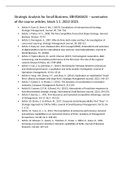Summary
Summary Strategic Analysis for Small Business article summaries
- Course
- Institution
Strategic Analysis for Small Business, EBM060A05 – summaries of the course articles, block 1.1, . • Article 0: Gans JS, Stern S, Wu J. (2019), Foundations of entrepreneurial strategy, Strategic Management Journal, 40, 736–756. • Article 1: Porter, M. E., 2008, The Five Competitive Forces...
[Show more]



